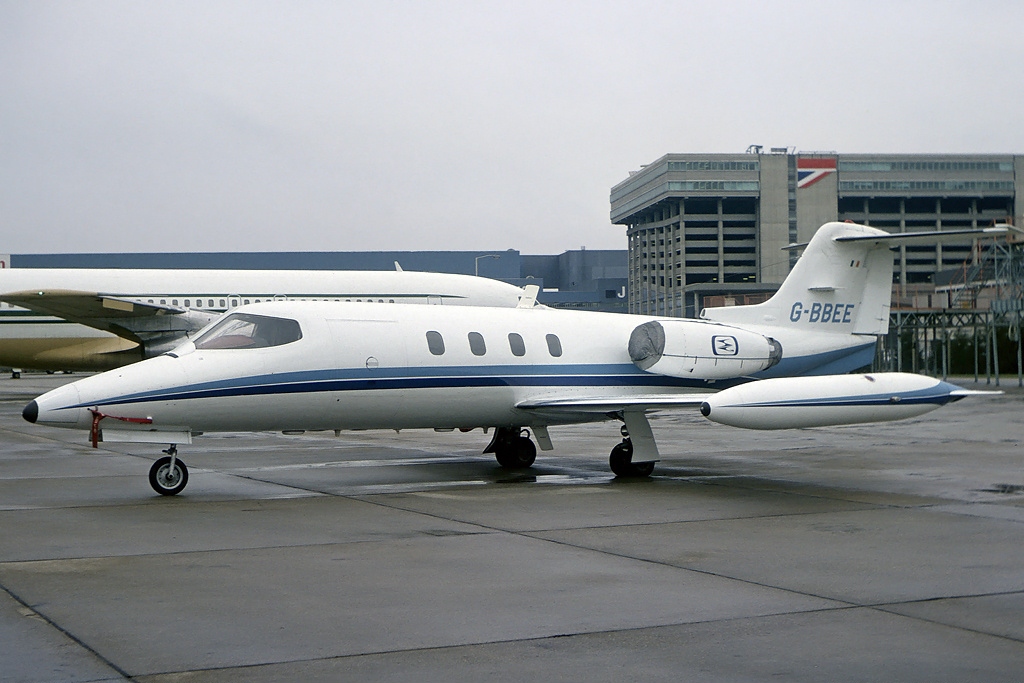Learjet 23
First delivered in 1964, the Learjet 23 was the very first Learjet model. It essentially created its own category of fast and efficient business jets, and other manufacturers followed suit. Now owned by Bombardier, Learjets were initially produced by the Lear Jet Corporation. Due to a noise compliance issued by the FAA in 2015, many older Learjets can no longer be operated in the United States unless granted special flight authorizations or equipped with FAA-approved hush kits.
The Lear 23 is equipped with two General Electric CJ610-4 engines. It has a normal cruise speed of 423 knots, a range of 1,000 nautical miles, a climb rate of 6,900 feet per minute, and requires 2,940 feet of runway to takeoff and 2,800 to land.
Learjet 24
In 1965, the Lear Jet Corporation began delivering the Learjet 24, which was designed as an improved version of the Lear 23. The Lear 24 comes with an increased maximum takeoff weight, from 12,500 pounds for the Lear 23 to 13,000 for the Lear 24. It also features increased cabin pressurization, the addition of an extra window on each side of the cabin, more powerful engines, a new windshield, auxiliary fuel in wing tip tanks, and a new engine fire extinguishing system. The Lear 24 has five different variants: the 24A, 24B, 24D, 24E and 24F (the 24C was abandoned during production). The 24A is the standard model, the 24B comes equipped with improved engines that give it a higher cruise speed and further range, the 24D is a lighter-weight model, and the 24E and 24F come equipped with aerodynamic improvements. The F model has a further range than the E due to an additional fuel tank, but the E model has a higher payload.
The original Lear 24A comes equipped with two General Electric CJ610-4 engines. It has a normal cruise speed of 417 knots, a range of 880 nautical miles, a climb rate of 6,300 feet per minute, and requires 4,193 feet of runway to takeoff and 4,073 to land. The B model comes with tweaked General Electric CJ610-6 engines, increasing its cruise speed to 428 knots and increasing its range to 1,000 nautical miles. The D, E, and F models all operate similarly to the B model, with the exception of the E model’s reduced range of 850 nautical miles.
Learjet 25
In 1968, deliveries of the Lear 25 began to take place. The biggest difference between the 25 and 24 is an increased fuselage length. The 25 is four feet and two inches longer, giving it room for an extra three passengers. Like the Lear 24, the Lear 25 has a number of variants, including the 25B, 25C, 25D and 25G. The D and G models come equipped with upgraded CJ610-8A engines, compared to the CJ610-6 engines on the other 25 models.
The Lear 25, 25B and 25C operate with nearly identical performance specs, though the C has a range about 150 miles longer than the other two. The Lear 25 and 25B have a normal cruise speed of 442 knots, a range of 1,385 nautical miles, a climb rate of 6,050 feet per minute, and require 5,186 feet of runway to takeoff and 2,703 to land. The D model has a normal cruise speed of 256 knots, a range of 1,431 nautical miles, a climb rate of 6,830 feet per minute, and requires 3,937 feet of runway to takeoff and 2,817 to land. The G model has a normal cruise speed of 464 knots, a range of 1,800 nautical miles, a climb rate of 5,720 feet per minute, and requires 4,950 feet of runway to takeoff and 2,728 to land.
[ulp id=’ksrvpykbSKmvluGu’]

